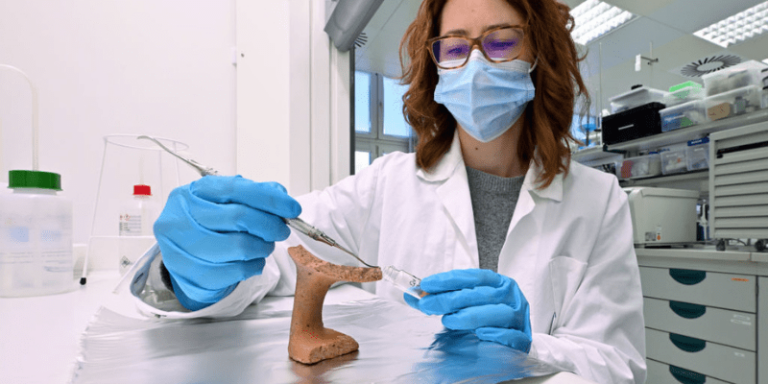The Spill: How Many Trees on Earth?
Weekly news you can use.
By: GenZ Staff | November 27, 2020 | 941 Words

Odeuropa scientist working on a shard of clay that was probably part of an incense burner. With the help of new technologies, chemists and archaeologists can explore flavors and smells of the past. (Photo by Martin Schutt/picture alliance via Getty Images)
NASA Tree Counters
How many trees are there? As impossible as it may sound, NASA plans to find out! Scientists plan to use a high-resolution satellite and artificial intelligence to count every single tree on Earth – from major forests to smaller groups and even lone trees. Blue Waters at the University of Illinois is one of the fastest supercomputers in the world, and it has been engaged in performing a “deep learning” on terrain images from parts of West Africa. Until now, much of the research on trees has been in large forests. They discovered that they could count trees that the older satellites cannot see, but even more exciting, they can assess the carbon storage potential of those trees as well. “These dry areas are white on maps – they are basically masked out because normal satellites just don’t see the trees,” said Martin Brandt, lead author in the study. “They see a forest, but if the tree is isolated, they can’t see it. Now we’re on the way to filling these white spots on the maps. And that’s quite exciting.” Climate control is a concern around the globe. Counting and having an accurate number of trees gives scientists a sense of how much carbon the planet can store as well as how it can change over time. Given time, these studies will be able to help track deforestation by comparing one year to another. The information will help determine if conservation efforts are working. It will also help landowners who get carbon credits for storing certain amounts of carbon.
“These dry areas are white on maps – they are basically masked out because normal satellites just don’t see the trees,” said Martin Brandt, lead author in the study. “They see a forest, but if the tree is isolated, they can’t see it. Now we’re on the way to filling these white spots on the maps. And that’s quite exciting.” Climate control is a concern around the globe. Counting and having an accurate number of trees gives scientists a sense of how much carbon the planet can store as well as how it can change over time. Given time, these studies will be able to help track deforestation by comparing one year to another. The information will help determine if conservation efforts are working. It will also help landowners who get carbon credits for storing certain amounts of carbon.
Presidential Confusion
The 2020 presidential election hasn’t gone as smoothly as planned. It’s almost December, and the American people are still not sure whether Donald Trump or Joe Biden will hold the next term office. One of the main reasons for this is the possibility of voter fraud. The president has challenged several states to perform a recount on the votes, and Georgia and Wisconsin have already started. Georgia Officials discovered more than 5,000 uncounted votes, which reduced Biden’s lead by about 10%. On November 24, election workers began a machine recount of nearly five million votes that were cast. The recount was approved because state law says a candidate can request a recount if the winning margin is less than 0.5%. In this case, Biden was reported to be ahead by 12,670 votes which equals 0.25%. Georgia is important in the presidential race; it’s considered a battleground state. Currently, it has two Senate runoff races going that will determine which party will control the chamber. Wisconsin In Wisconsin, there were almost 400 absentee ballots from Milwaukee that were not opened and counted. President Trump’s team paid for a recount. Although it is early in the process, the recounted ballots (which do not include the unopened votes) showed Trump had gained 57 more votes than previously recorded. The errors in Georgia and Wisconsin are only some of the issues from the election that the president is protesting. While some recounts may not show a big change, the fact that there are so many issues with missing and uncounted ballots shows the necessity for making sure Americans are getting and participating in a fair and just election.
Smelling the World
Humans are equipped with five senses: sight, hearing, touch, taste, and smell. Each is powerful in its own way. Sometimes, if one sense is lost, the others become stronger and more sensitive. A blind person, for example, will sometimes have a better sense of hearing and smell to help make up for the loss of sight. And now, a group of researchers want to give the gift of smell throughout the ages in an online “Encyclopedia of Smell Heritage.”
The group formed what they call the Odeuropa consortium. They’re in the process of recording familiar and odd smells for people to experience. These odors range in time periods and objects. Some of the scents they plan to feature include scented tobacco that was used by perfumers, motor oil and ozone that was found in texts by Italian futurists, and much more. “Much more so than any other sense, our sense of smell is linked directly to our emotions and our memories,” Odeuropa said. The lead investigator of the group, Inger Leemans, said her team would “dive into digital heritage collections to discover key scents of Europe and bring them back to the nose.” And Matija Strlic of the University College London explained that “Old smells, or smells of objects, tell us a lot about how those objects degrade, how they can be preserved, and also how those smells can be conserved.”
“Once you start looking at printed texts published in Europe since 1500 you will find loads of references to smell, from religious scents – like the smell of incense – through to things like tobacco,” said Dr. William Tullett of Anglia Ruskin University in Cambridge. Tullett is also a member of the Odeuropa team and is the author of Smell in Eighteenth-Century England. The project is scheduled to officially begin in January and is expected to take three years. The first step will be to develop artificial intelligence responsible for screening historical texts, in seven languages, for descriptions of odors from the past, as well as how these smells were used in context. The AIs will also look for aromatic items in paintings and drawings. That information will be used to create the encyclopedia of smells. “It will [also] include discussions of particular types of noses from the past – the kinds of people for whom smell was significant and what smell meant to them,” said Tullett. An example, he said, would be physicians. 
















